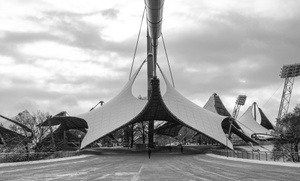Foucault’sches Pendel – Die Erde dreht sich
In the organizer's words:
Weather station, transmission mast, vantage point and pendulum home: the tower of the Deutsches Museum is much more than the museum's architectural landmark. The entrance on the first floor is located at the transition between the exhibitions Model Railways and Bridges and Hydraulic Engineering. Before you climb the steps to the exhibitions on the upper levels or take the elevator to the viewing platform for a guided tour, it's worth stopping here. Right next to the elevator, you can see a Foucault pendulum in action.
A 30 kg lead ball can be seen swinging slowly back and forth on a 60 m long wire rope. Underneath the sphere is a circular disk with a diameter of 3 m, which indicates the cardinal points and on which more than 60 movable cones are placed in a semicircle. The sphere always swings in the same plane. Nevertheless, after a few minutes it knocks over one cone after the other, proving that the earth - beneath the pendulum - is rotating. And it doesn't do so slowly at all: at our latitude, the earth rotates at a speed of around 1117 km/h.
To the left of the pendulum you can see another, much larger sphere: The physicist Philipp von Jolly (1809-1884) used this lead ball weighing almost 5800 kg to determine the density of the earth.
Live every day. New every day. For individual visitors and small groups of up to five people, guided tours, demonstrations, science shows and hands-on programs in various exhibitions take place daily, free of charge and without registration. The current daily program is published every day at around 9:20 a.m. on the website and in the Deutsches Museum app.
This content has been machine translated.












